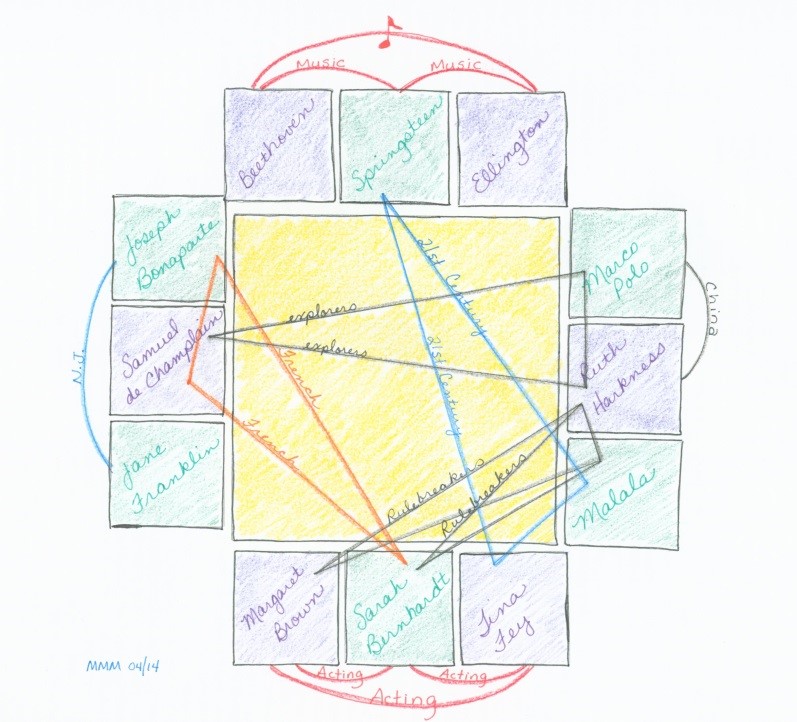Page 1 Page 2
CONNECTIONS
William Butler Yeats said, “Some people live life; others make sense of it.” I’m afraid I’m more of the latter. I like to work with data to understand it from different perspectives. This can be done with mind maps, or some other technique appropriate for the material. Once I was familiar with my collection of twelve subjects, I imagined them together in a room and tried to picture who would be talking to whom. This reminded me of that old conversation-starter where you ask a person, “Who are the ten people, living or dead, that you would invite to your fantasy dinner party?” Silly as it sounds, working out the seating chart for these twelve helped me discover connections between them. What are they talking about while I’m in the kitchen preparing the food?
- Ludwig van Beethoven, Bruce Springsteen, and Duke Ellington would chat about music, but one of them probably wouldn’t be open-minded about the music of the others.
- Joseph Bonaparte, Sarah Bernhardt, and Samuel Champlain would chat in French.
- Samuel Champlain, Ruth Harkness, and Marco Polo could talk about exotic places they’ve explored with Harkness and Polo comparing notes about China.
- Ruth Harkness , Margaret Brown, Sarah Bernhardt, and Malala Yousafzai would connect over glass ceilings they’ve broken.
- Malala Yousafzai, Bruce Springsteen, and Tina Fey could discuss fame in the twenty-first century.
- Tina Fey, Margaret Brown, and Sarah Bernhardt would discuss their love of acting.
- Beethoven and Joseph Bonaparte would probably discuss the rise and fall of Napoleon Bonaparte. Beethoven, by the way, had originally dedicated his Third Symphony (“Eroica”) to Napoleon, but scratched-out the dedication when Napoleon declared himself emperor. Beethoven inscribed instead, “To the memory of a great man.”
SELECTING BIOGRAPHIES
These trends helped me put together my Biography Selection Criteria Checklist, in the form of six questions.
- Is the biography scholarly, and therefore useful for research, or is it conversational and more likely intended for entertainment? If it is to be used for research, does it have a useful index or detailed table of contents?
- The Bonaparte, Beethoven, Springsteen, Polo, Brown, and Champlain biographies are scholarly.
- Tina Fey’s and Malala Yousafzai’s are informal and conversational, known as Essay biographies. These books are portraits intended for entertainment.
- Was the book written by the subject themselves, and thus an autobiography or memoir?
- Tina Fey’s and Malala Yousafzai’s are autobiographies.
- If the biography was written by another party, what kind of access did the biographer have to the subject, people in the subject’s life (for interviews), or primary sources in libraries and archives?
- In the case of Jane Franklin, there is very little written on the subject, but an infinite amount on her brother.
- Does the biography cover the whole life of the subject (narrative biography) or just a part?
- Springsteen’s biography starts before his birth with his grandparents and parents and brings the reader up to the present day.
- Does the biography split the subject’s life into parts or facets (topical biography)?
- For example, Beethoven as a man and Beethoven as a musician.
- Is the biography about two people, such as the Jane Franklin/Benjamin Franklin work? (This is called an “And” biography by Milton Lomask.)
BIOGRAPHIES OF THE OBSCURE
Once colleagues learned about my biography project, I received many suggestions of books to include. I had already selected most of my biographies, but one suggestion I’m glad I listened to was Book of Ages: The Life and Opinions of Jane Franklin by Jill Lepore (2013). This is a very different kind of biography, because in it Lepore asks, “What would it mean to write a history concerned not only with the lives of the famous but also with the lives of the obscure?” (Lepore. p. 242). Lepore uses the famous life of Benjamin to illuminate the obscure life of Jane Franklin Mecom. Lepore adds facts from what we know about girls’ and women’s lives then to knowledge gleaned from Benjamin’s letters to Jane. All we have in Jane’s hand is her “Book of Ages” in which she recorded family birth, marriage, and death dates. Jane’s letters to Benjamin were probably discarded, as they would have been considered “unimportant.”
Jill Lepore is not the first to write about Jane Franklin. A famous biographer named Carl Van Doren wrote a biography of Benjamin Franklin which won the Pulitzer Prize in 1939. Van Doren followed that up with a biography of Jane in 1950. Reviewer Esther Forbes wrote in the New York Herald Tribune Book Review: “Mr. Van Doren was too civilized a man to be interested only in the great,” (Forbes, p. 1).
FINAL THOUGHTS
A long time ago, I read that biographies are a vital part of any historical study. Learning about the people involved in history, or history-in-the-making, creates a new facet to knowledge. For example, studying the life of Duke Ellington fortified and enhanced my course on the Harlem Renaissance. Learning about Joseph Bonaparte’s exile near my hometown informs my knowledge of that region’s history. Malala Yousafzai’s story helps me understand the plight of young women in Pakistan, and learning that Samuel de Champlain brought my French ancestors to Nova Scotia joins me to my family history.
My area of study for this year is Visual Art, and I’ve already included (and mind-mapped) a few essential biographies for my Art Year. I read about Albert C. Barnes, who made millions in the pharmaceutical industry and spent much of it creating his own private art museum just outside Philadelphia. (It has been moved to Center City Philadelphia in recent years and is open to the public.) I also enjoyed a graphic-novel-style biography of Andy Warhol, appropriate for that artist’s aesthetic. My understanding of art is richer for the knowledge of its creators, as well as the creations.
Page 1 Page 2
Pages: 1 2



